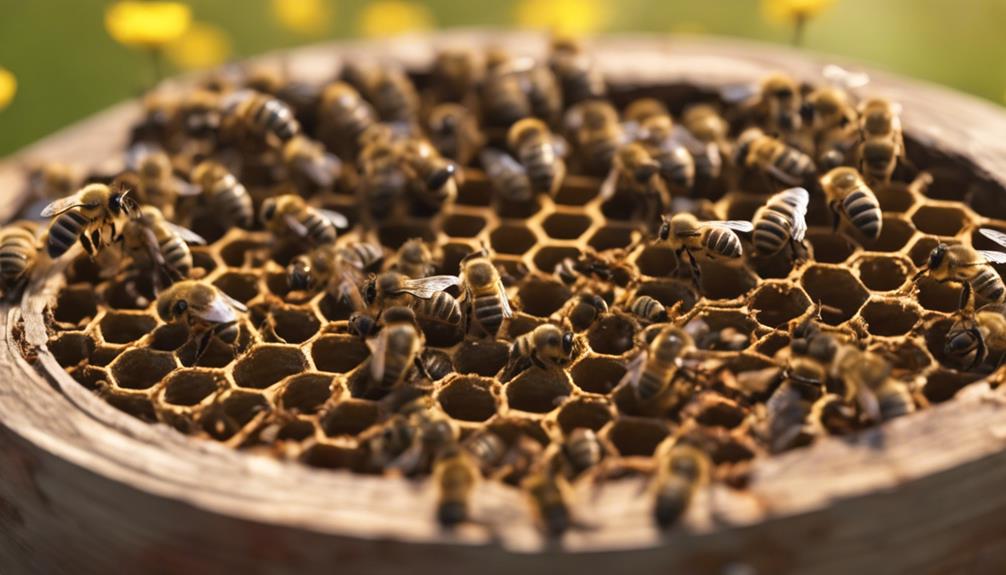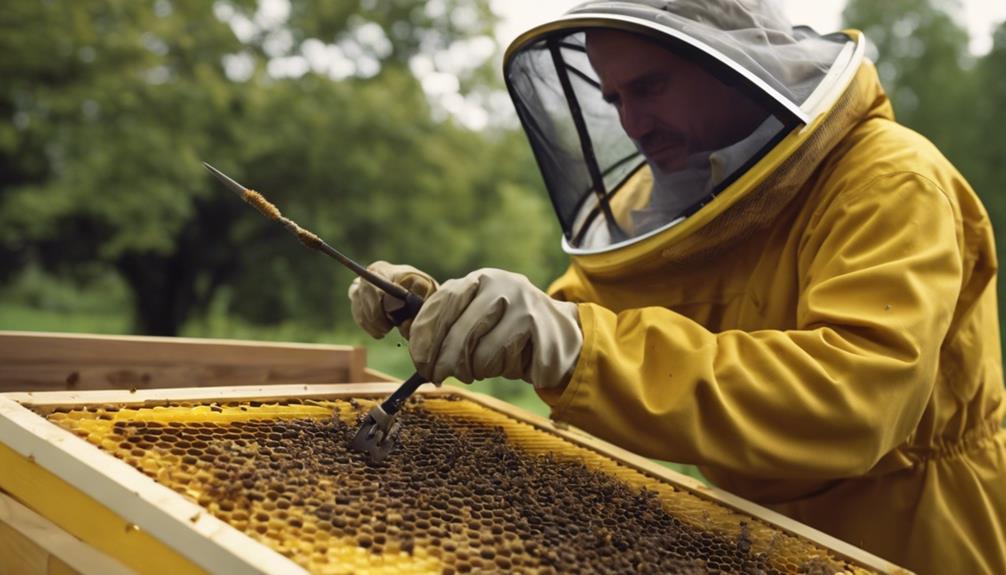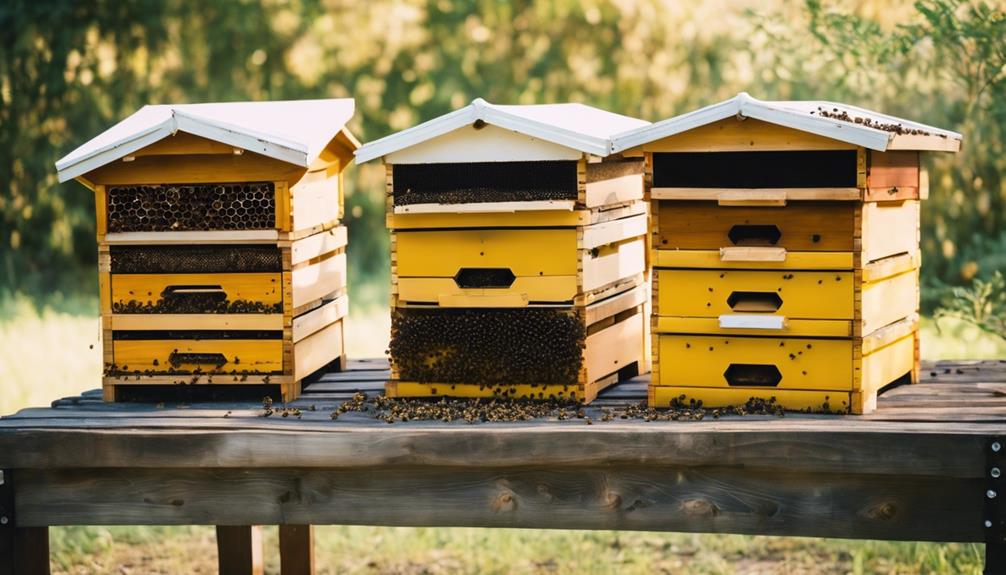When you spot that mysterious hole in the inner cover of a hive, it’s not just for show! That opening serves multiple essential purposes, like allowing easy access to the roof cavity, fitting an upside-down jar feeder for bee feeding, and even indicating the colony’s strength. It also plays a role in regulating bee traffic, maintaining proper ventilation, and balancing temperature and humidity for the bees’ well-being.
These little holes are like secret passageways for our buzzy friends, guiding them in their daily activities and helping us keep an eye on their health and behavior. Stay tuned, as there’s more to discover about how these openings impact hive management and beekeeping efficiency!
Main Points
- Facilitates easy access to the roof cavity for bee management.
- Accommodates an upside-down jar feeder for bee feeding convenience.
- Serves as an indicator of colony strength for monitoring.
- Helps monitor potential swarming activity within the hive.
- Emphasized in the Flow Hive Classic Assembly Guide for importance.
Purpose of the Hole in the Inner Cover
Why does the hole in the inner cover serve an important role in beekeeping practices?
The hole in the inner cover plays a crucial role in maintaining a healthy bee colony. It allows for easy access to the roof cavity, enabling beekeepers to inspect and manage the colony efficiently. Additionally, this hole accommodates an upside-down jar feeder for bee feeding, ensuring that our buzzing friends are well-fed and thriving.
Not only does it provide practical benefits, but the presence of bees in the roof through this hole also serves as an indicator of the colony’s strength. Keeping an eye on this opening can help us monitor potential swarming activity, allowing us to take necessary precautions and maintain a harmonious beekeeping environment.
The Flow Hive Classic Assembly Guide highlights these essential functions, emphasizing the significance of the inner cover hole in beekeeping practices.
Functionality of the Hive Opening
Let’s talk about the functionality of the hive opening.
This small hole plays an essential role in maintaining proper ventilation within the hive. It also helps regulate the traffic of bees in and out of the hive, ensuring order and efficiency in their activities.
Hive Ventilation Needs
The hive opening in the inner cover serves as an essential pathway for regulating temperature and humidity within the hive. This small hole plays a significant role in keeping our bee colony healthy and thriving.
By allowing air circulation, it helps maintain the right balance of warmth and moisture essential for bee well-being. Imagine it as nature’s own thermostat, ensuring our bees stay cozy in winter and cool during summer.
Proper ventilation through this opening prevents condensation buildup, protecting our hive from excess moisture that could lead to mold growth. It’s like giving our bees a fresh breeze, keeping their home fresh and conducive to their needs.
Bee Traffic Control
In our hive, the opening in the inner cover functions as a crucial pathway for controlling bee traffic within the colony. This small entrance not only regulates bee movement but also serves as an indicator of colony strength.
When bees use this opening to access the roof cavity, it signals a healthy and active hive. Monitoring bee traffic through this hole can also provide valuable insights into potential swarming behavior, helping beekeepers manage their hives effectively.
Importance of Bee Escapes

Bee escapes play an essential role in honey harvesting by guiding bees out of the super without letting them back in.
Understanding bee behavior is key as these devices rely on the insects’ natural instincts.
Using bee escapes can significantly boost efficiency when collecting honey, making the process smoother for both beekeepers and bees.
Bee Escape Purpose
With their ability to facilitate bee removal from honeycombs before harvest, bee escapes play an important role in streamlining the honey collection process for beekeepers. Bee escapes are designed to allow bees to exit a super without being able to re-enter, making it easier for beekeepers to extract honey.
These handy tools are commonly used in commercial beekeeping operations due to their efficiency in clearing bees from honeycombs. By using bee escapes, beekeepers can minimize the presence of bees in the honey supers during extraction, providing a gentle method that reduces disruption and stress for the bees.
This essential tool not only helps clear bees before harvest but also ensures a smoother and more peaceful honey extraction process.
Bee Behavior Influence
One significant aspect influencing bee behavior within a hive is the strategic placement of bee escapes on the inner cover. Bee escapes are like the secret passages in a castle, guiding our buzzing friends out of the honey supers before we start our honey harvesting quest.
These clever contraptions help us in our beekeeping adventures by reducing the disturbance to the colony during honey extraction. The design of the hole in the inner cover is vital, as it directs bee movement within the hive, making our honey harvesting endeavors more efficient.
With bee escapes in place, our bee buddies can navigate smoothly, allowing us to collect honey with ease and harmony. It’s like a well-choreographed dance, where everyone knows their steps, leading to a sweet and fruitful outcome.
Harvesting Efficiency Boost
Improving the honey harvesting process with effectiveness and ease is greatly boosted by the strategic integration of bee escapes through the inner cover hole. Bee escapes are like the VIP pass for bees during harvest time, guiding them out of the supers smoothly.
Picture this: as the bees make their grand exit through the one-way exit, beekeepers can peacefully collect the honey without causing a buzz. It’s a win-win situation – efficient for us and bee-friendly for our little pollinator friends.
The hole in the inner cover isn’t just a gap; it’s a gateway to smoother honey extraction. By using bee escapes, we’re not just saving time but also ensuring a valuable and sustainable practice in beekeeping.
Role in Harvesting Honey
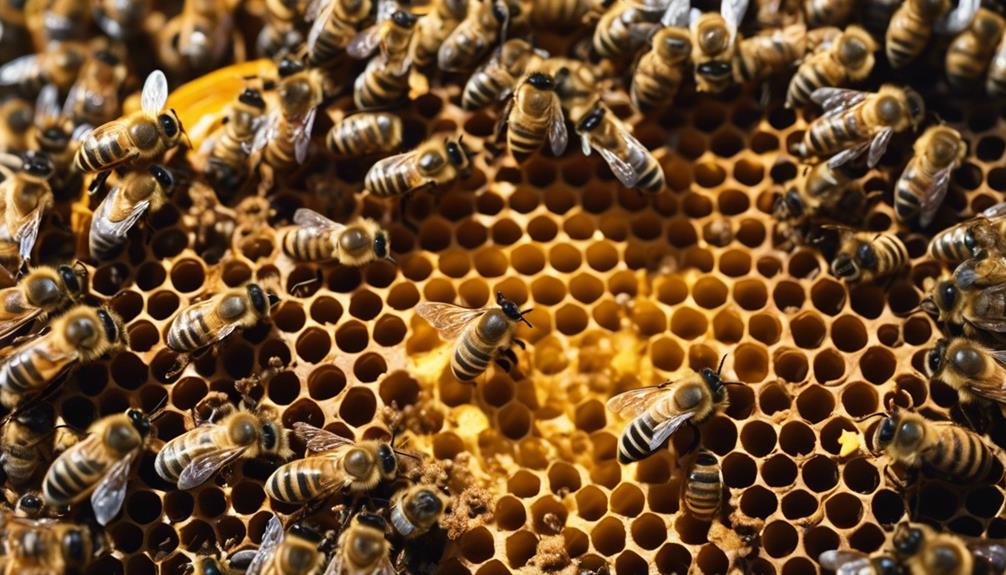
The opening in the inner cover of a hive plays a crucial role in facilitating honey harvesting by providing easy access for monitoring and managing the hive. This clever design allows beekeepers to keep a close eye on their buzzing friends during the honey extraction process.
By peeking through this opening, we can observe the colony’s activity levels and make sure everything is running smoothly. Additionally, when it’s time to harvest that sweet, golden honey, this access point becomes our best friend. It lets us check on the bees and their honey production without causing too much disruption.
Enhancing Hive Efficiency
To boost hive efficiency, we prioritize optimizing the inner cover hole for seamless hive management.
- Feeding Ease: The hole accommodates an upside-down jar feeder, simplifying the feeding process for our bees.
- Colony Strength Indicator: It allows bees access to the roof cavity, serving as an indicator of colony strength and potential swarming activity.
- Covering Options: Consider using screen mesh or thin ply wood to cover the hole, taking into account propolization tendencies and insulation needs.
Properly managing this hole is vital for hive health. It helps bees can feed easily, aids in monitoring their well-being, and contributes to maintaining the best hive conditions. By choosing the right covering and understanding its significance, we improve the hive’s functionality and efficiency.
Facilitating Bee Movement
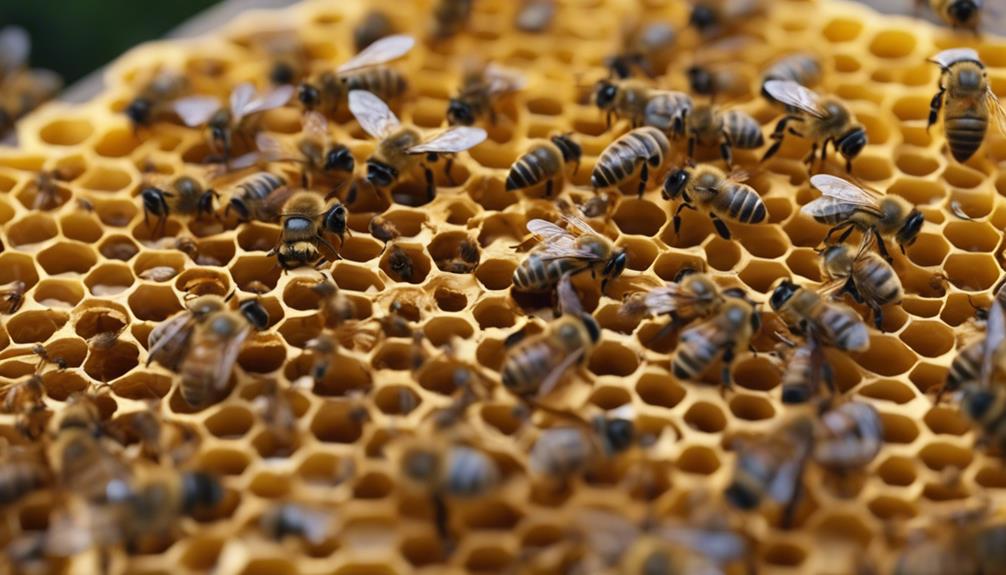
Facilitating bee movement through the inner cover hole is vital to understanding hive dynamics and evaluating colony health. Bees utilize this opening for various essential activities like ventilation, clustering, and communication. It serves as a pathway for bees to access the roof cavity, where they store honey, pollen, and propolis.
Observing bee movement through this hole provides insight into the colony’s strength and activity levels. Monitoring the traffic through this entrance not only helps in gauging hive health but also allows beekeepers to anticipate potential issues such as swarming. Understanding how bees utilize this hole is essential for beekeepers to maintain a thriving hive and support the bees’ natural behaviors.
Significance of Oval Shape
When considering the significance of the oval shape in hive inner covers, beekeepers often prioritize its functionality for accommodating bee escapes in honey supers. Here’s why oval shapes matter in beekeeping design:
- Porter Bee Escapes: Some beekeepers prefer oval holes as they perfectly fit specific equipment like Porter bee escapes, aiding in efficient bee management.
- Historical Hand Grips: Oval openings may have served dual purposes in the past, not only for bee escapes but also as convenient hand grips for beekeepers when handling the inner covers.
- Origin and Adaptation: The design of oval openings, possibly originating with the Porter Bee Escape concept, showcases the adaptability of beekeeping equipment to meet evolving needs, emphasizing the significance of this unique shape in hive management.

Hello! My name is Noel Calvin. I graduated from UCLA and now work as a writer at Launch Ninjas. I write blog posts that inspire and guide our readers in their entrepreneurial pursuits. I live in Pleasantville, NJ, with a peaceful yet lively atmosphere that inspires me.
Writing stories is more than just a job for me. It allows me to share my observations and satisfy my curiosity about the world. I combine my analytical skills with creative enthusiasm to delve into technology trends and startup stories. But my life isn’t limited to screens and keyboards. I value loyalty, passion, and a touch of old-fashioned charm, which I infuse into every narrative I create.
I love spending time in my garage, jamming with my band when I’m not writing. Playing the guitar and singing bring me immense joy. I also enjoy capturing ordinary and extraordinary moments through my camera lens and exploring new culinary adventures that excite my taste buds. I’m always seeking new experiences.
My family is very important to me. Joyful Sunday brunches filled with laughter and intense board game nights keep me grounded, reminding me of life’s simple pleasures.
In my world, every moment is an opportunity for discovery. Every discovery is a story worth sharing, whether a heartfelt moment at home or the pulse of technological innovations. Join me as I navigate through life, one blog post, one guitar strum, and one heartwarming family dinner at a time.
